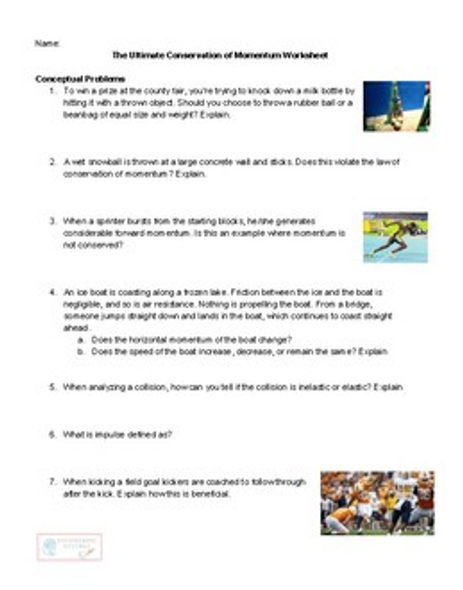Description
This zip file contains several activities (48 pages of student handouts and 1 PowerPoint with a total of 21 slides) which can be used to compose a unit for physics students involving topics relating to momentum, impulse, practical applications of momentum and impulse and the pendulum. Topics in this unit include momentum and impulse including calculations, practical applications of momentum and impulse such as parachutes and crumple zones in vehicles and the pendulum including studying the factors influencing its swing and pendulum calculations involving period, frequency, component forces as well as other concepts.
Activities simulating the egg drop lab relating to momentum and impulse as well as a pendulum lab computations are included in this package. No specialized materials are required for this activity.
These materials may be used in Physics or advanced Physical Science classes. Knowledge of calculus is not required to complete the included activities. The components in this unit correlate to NGSS Standard HS-PS 2.1. The NGSS Standard, Common Core Standards and learning objectives addressed are indicated at the end of this description.
The learning materials in this package can be easily adapted to distance learning settings or for students in quarantine.
The components of this lesson package can easily be displayed to students using and LCD projector and may be readily modified into formats facilitating smartboard technology.
All documents except for the PowerPoint are included in both word as well as pdf format to allow editing for specific teacher needs. All answer keys are included. The specific contents of the learning package includes the following items (the page count for these items are actual student handouts as answer key page counts are not included):
- Momentum, Impulse and the Pendulum Scaffolded Completion Notes (9 pp.)
- PowerPoint to accompany the Scaffolded Notes (21 slides)
- Momentum and Impulse Worksheet (32 questions) (5 pp.)
- Momentum and Impulse Quiz (32 questions) (8 pp.)
- Pendulum Worksheet (25 questions) (5 pp.)
- Egg Drop Simulation Lab Activity (8 pp.)
- Pendulum Lab (10 pp.)
- Additional Resource Links for the Unit (1 p.)
- NGSS, Common Core and Local Learning Standards/Objectives (2 pp.)
Learning Objectives
Upon the completion of this unit the student will be able to:
1. define the term momentum.
2. perform calculations involving the equation p = mv.
3. explain what momentum is a vector quantity.
4. recognize the direction of the momentum of an object is the same as its velocity.
5. define the term impulse.
6. recognize impulse is a vector quantity.
7. perform calculations involving I = Fnet(t).
8. recognize the value for the momentum of an object is equal to the value for the impulse of an object and perform calculations of m∆v = Fnet(t).
9. discuss some practical applications of momentum and impulse.
10. explain what is meant by a closed system.
11. state the law of the conservation of momentum.
12. list the components of a simple pendulum.
13. explain how to measure the length of a pendulum.
14. define the following terms related to the simple pendulum; bob, equilibrium position and amplitude.
15. explain what is meant by the frequency and period of a pendulum.
16. use the equation T = 1/f to calculate the period or frequency of the pendulum.
17. describe how changes in length influence the period of a pendulum.
18. recognize that for amplitude values of 15 degrees or less that changes in amplitude or mass of the bob do not influence the period of a pendulum.
19. utilize the equation T = 2π (l/g)1/2 in computations.
20. describe several forces acting upon a swinging pendulum.
21. recognize without friction or air resistance that a swinging pendulum would swing forever.
22. define the terms potential energy, kinetic energy and total mechanical energy.
23. recognize the total mechanical energy of a closed system remains constant.
24. discuss the potential and kinetic energy changes which occur during the swinging of a simple pendulum.
NGSS Standards Addressed
HS-PS2-2. Use mathematical representations to support the claim that the total momentum of a system of objects is conserved when there is no net force on the system.
HS-PS2-3. Apply scientific and engineering ideas to design, evaluate, and refine a device that minimizes the force on a macroscopic object during a collision.
Common Core State Standards Connections:
ELA/Literacy
WHST.9-12.7 Conduct short as well as more sustained research projects to answer a question (including a self-generated question) or solve a problem; narrow or broaden the inquiry when appropriate; synthesize multiple sources on the subject, demonstrating understanding of the subject under investigation.
Mathematics
MP.2 Reason abstractly and quantitatively.
MP.4 Model with mathematics.
HSN-Q.A.1 Use units as a way to understand problems and to guide the solution of multi-step problems; choose and interpret units consistently in formulas; choose and interpret the scale and the origin in graphs and data displays.
HSN-Q.A.2 Define appropriate quantities for the purpose of descriptive modeling.
HSN-Q.A.3 Choose a level of accuracy appropriate to limitations on measurement then reporting quantities.
HSA-CED.A.1 Create equations and inequalities in one variable and use them to solve problems.
HSA-CED.A.2 Create equations in two or more variables to represent relationships between quantities; graph equations on coordinate axes with labels and scales.
HSA-CED.A.4 Rearrange formulas to highlight a quantity of interest, using the same reasoning as in solving equations.
Terms of Use
Purchase of the product is for classroom use by the purchaser only. It is a violation for individuals, schools, and districts to redistribute or sell this item on the Internet or to other individuals. I do encourage you to use and edit these documents to suit your needs with your own students in distance learning environments.
This work is licensed under a Creative Commons Attribution-NonCommercial-ShareAlike 4.0 International License.


















